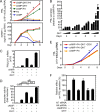The androgen and progesterone receptors regulate distinct gene networks and cellular functions in decidualizing endometrium
- PMID: 18511503
- PMCID: PMC5393297
- DOI: 10.1210/en.2008-0356
The androgen and progesterone receptors regulate distinct gene networks and cellular functions in decidualizing endometrium
Abstract
Progesterone is indispensable for differentiation of human endometrial stromal cells (HESCs) into decidual cells, a process that critically controls embryo implantation. We now show an important role for androgen receptor (AR) signaling in this differentiation process. Decreased posttranslational modification of the AR by small ubiquitin-like modifier (SUMO)-1 in decidualizing cells accounted for increased responsiveness to androgen. By combining small interfering RNA technology with genome-wide expression profiling, we found that AR and progesterone receptor (PR) regulate the expression of distinct decidual gene networks. Ingenuity pathway analysis implicated a preponderance of AR-induced genes in cytoskeletal organization and cell motility, whereas analysis of AR-repressed genes suggested involvement in cell cycle regulation. Functionally, AR depletion prevented differentiation-dependent stress fiber formation and promoted motility and proliferation of decidualizing cells. In comparison, PR depletion perturbed the expression of many more genes, underscoring the importance of this nuclear receptor in diverse cellular functions. However, several PR-dependent genes encode for signaling intermediates, and knockdown of PR, but not AR, compromised activation of WNT/beta-catenin, TGFbeta/SMAD, and signal transducer and activator of transcription (STAT) pathways in decidualizing cells. Thus, the nonredundant function of the AR in decidualizing HESCs, centered on cytoskeletal organization and cell cycle regulation, implies an important role for androgens in modulating fetal-maternal interactions. Moreover, we show that PR regulates HESC differentiation, at least in part, by reprogramming growth factor and cytokine signal transduction.
Figures






References
-
- Lydon JP, DeMayo FJ, Funk CR, Mani SK, Hughes AR, Montgomery Jr CA, Shyamala G, Conneely OM, O'Malley BW 1995. Mice lacking progesterone receptor exhibit pleiotropic reproductive abnormalities. Genes Dev 9:2266–2278 - PubMed
-
- Brosens JJ, Hayashi N, White JO 1999. Progesterone receptor regulates decidual prolactin expression in differentiating human endometrial stromal cells. Endocrinology 140:4809–4820 - PubMed
-
- Gellersen B, Brosens IA, Brosens JJ 2007. Decidualization of the human endometrium: mechanisms, functions, and clinical perspectives. Semin Reprod Med 25:445–453 - PubMed
-
- Kajihara T, Jones M, Fusi L, Takano M, Feroze-Zaidi F, Pirianov G, Mehmet H, Ishihara O, Higham JM, Lam EW, Brosens JJ 2006. Differential expression of FOXO1 and FOXO3a confers resistance to oxidative cell death upon endometrial decidualization. Mol Endocrinol 20:2444–2455 - PubMed
-
- Gellersen B, Brosens J 2003. Cyclic AMP and progesterone receptor cross-talk in human endometrium: a decidualizing affair. J Endocrinol 178:357–372 - PubMed
Publication types
MeSH terms
Substances
Grants and funding
LinkOut - more resources
Full Text Sources
Other Literature Sources
Research Materials

